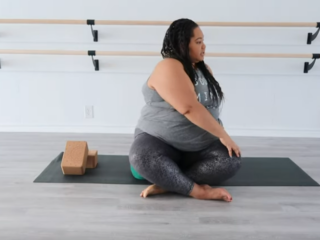Yoga is a great way to reduce eye strain and improve vision. These 10 yoga eye exercises can help you achieve these benefits.
The eye exercises for eye strain are yoga exercises that can help reduce the effects of eye strain.
It’s possible that some of the links in this article are affiliate links. For additional information, please read our disclaimer.
Your eyes are said to be the window to your soul. Your eyes provide you with a distinct physical and spiritual perspective of the world in addition to assisting you in seeing and navigating it. Your eyes are very essential, and it is as vital that you look after them!

I’m sure your parents warned you as youngsters not to sit too close to the television or read in the dark because it might strain your eyes. We put a lot of pressure on our eyes as adults without even recognizing it. Many of us spend up to eight hours a day staring at screens, or perhaps even more if you’re up late browsing through Facebook or Instagram.
So, what can you do to lessen the strain on your eyes? There are numerous activities you can do to revitalize your eyes in addition to resting them and giving them a vacation from your computer screen. There are even yoga movements to perform that concentrate on decreasing eye strain, believe it or not.
What is the definition of eye strain?
Eye strain happens when your eye muscles are held in one position for an extended period of time. To maintain your eye muscles healthy and functioning, you must alternate between resting and training them, just like any other muscle in your body.
The following are some of the signs and symptoms of eye strain:
- Squinting
- Rubbing of the eyes
- Eyes that are watering
- Headaches
- irritated eyes
- Eyes that are tired
- Eyes that itch
- Light sensitivity has increased.
- Dry eyes
- Concentration problems
- Double eyesight or hazy vision
Eye Strain Prevention Tips
Eye strain may develop over time or when doing a particular task, such as driving a long distance. Get inquisitive about your routines and how much rest you really offer your eyes if you want to avoid eye discomfort entirely.
The following are some eye strain prevention tips:
- Be careful of your computer or television screen: Avoid putting your computer or television screen too near to your face. Additionally, minimize glare on your screen as much as possible by utilizing Dark Mode or maintaining the brightness at a reasonable level.
- Make use of lighting: Whether you’re reading a book or crocheting, make sure you have enough light. Darkness may cause your eyes to strain harder, so having a decent source of light can make reading or working more comfortable.
- Wear your glasses or contacts: If you’ve been prescription glasses or contacts, make sure you’re wearing them to prevent squinting.
- Exercise and lubricate your eyes: Blink often and attempt yoga eye exercises to maintain your eyes healthy and refreshed. If you have dry eyes, you may also utilize eye drops.
- Improve indoor air quality: If your room is too dry or lacks enough circulation, invest in a humidifier or a few plants to help your eyes breathe better.
Yoga’s Eye Health Benefits
You may do a variety of eye workouts to help maintain your eyes healthy. These eye workouts relax all of our eyes’ intricate components, providing your eyes a much-needed break from their hard job. While eye strain has no severe or long-term consequences, limiting screen time and performing the activities below may help:
- Lessen the strain
- Prevent migraines and headaches.
- Prevent inflammation of the eyes.
- Allow your eyes to rest and relax.
- Stress and tension should be released.
- Maintain the health of your eyes.
Exercises for the Eyes
You may be familiar with yoga for the body, but what about yoga for the eyes? Are you interested in learning more about the practice? The exercises below are intended to alleviate daily pressure on your eyes.
Palming
If you need a vacation from your computer, this is a wonderful workout to do.
- Sit on a chair with your legs crossed.
- Close your eyes and keep your back straight.
- For approximately 15 seconds, rub your hands together to create friction and warmth.
- Bring your hands to your eyes and point your fingers skyward.
- With the heels of your palms, stroke your eyes and then your forehead.
- Allow yourself to relax and enjoy the warmth of your hands while closing your eyes.
Rolling of the eyes
It’s really good to roll your eyes! To alleviate fatigue and stress, do this exercise.
- Relax your breath and your eyes by sitting tall.
- To feel the back of your neck long, keep your head flat with your chin tucked slightly toward your chest.
- Roll your eyeballs upwards to gaze at the sky or the ceiling.
- Rotate your eyes slowly in a clockwise direction.
- Count how many objects you can see via your peripheral vision while doing this.
- Stop after three repetitions, relax your eyes, and then repeat in a counterclockwise circle.
Zooming
This practice may provide significant eye relief in only a few minutes. Take a break from your computer and try zooming out.
- Give yourself a thumbs up by extending one arm out in front of you.
- Set your attention on your thumb and gradually move it back towards your face until it is no longer in focus.
- Keep your thumb in contact with your eyes.
- Wait a few seconds before gently straightening your arm out while keeping your attention on your thumb.
- Practice at least three times.
Gazing at a distance
Focusing on a distant object may help your eyes relax, particularly if you spend all day looking at a computer.
- Find a faraway item to focus your attention on.
- Concentrate as much as you can on the item while keeping your eyes and face as calm as possible.
- Refocus your attention on a separate distant object while you take a deep breath in.
- Rep this exercise many times, moving your attention to different objects at different distances.
The Eighth Figure
Make a figure eight with your hand to strengthen your eyes.
- Take a seat on the floor in a comfy seat.
- Straighten your right arm out in front of you.
- Make a fist and give a thumbs up sign.
- Make a Figure 8 with your fist and follow it with your right eye while keeping your head steady.
- Reverse the procedure with your left hand and left eye.
Drishti
Drishti is a technique that is often used in yoga classes when in a yoga posture. Set your attention on an immovable object or point in front of you to practice dristhi. Concentrate all of your focus on that one place and don’t move your line of view. Here are some Drishti principles to get you started:
- Drishti Nasagram: at the tip of your nose
- Ajna Chakra, also known as Bhrumadhya Drishti, is a chakra located between the brows.
- Drishti of the Nabhi Chakra: at the navel
- Drishti hastagram: on your hand
- Drishti Padayoragram: on your toes
- Drishti Parshva: to the right
- Drishti Parshva: to the left
- Drishti Angushthamadhyam Angushthamadhyam Angushthamadhyam Angushthamadhyam Angush
- Up to the sky (Urdhva or Antara Drishti)
Trataka
This eye exercise may be utilized as a meditation technique as well.
- Create a calm, darkly lighted environment.
- Place a candle two feet in front of you and take a seat in something comfortable.
- Fix your attention on the candle’s flame.
- Direct your gaze to the center of the flame, just above the wick.
- Keep your gaze fixed on the flame for as long as possible.
- Allow your attention to concentrate entirely on the flame by blinking as required.
- Try practicing this meditation for three minutes and then remain as long as you like.
How Often Should Yoga for the Eyes Be Practiced?
Every day is a good day to practice eye yoga! It’s a good idea to practice not just once a day, but many times a day if you work at a computer all day or if your profession needs you to utilize your eyes for extended periods of time.
These eye exercises are quick and easy to perform, so all you need is a minute or two to reset your eyes and give them a rest. Look away from your computer every 20 minutes and do the workout of your choosing.
If you don’t strain your eyes on a regular basis, these eye exercises may be included into your everyday routine. When you first wake up, or just before you go to bed, practice one or two. These exercises will improve your eye health and help you minimize eye strain.
Healthy Foods for the Eyes
Eating properly not only keeps your body healthy, but it also helps your eyes stay healthy. Zinc, copper, vitamin C, vitamin E, beta carotene omega-3 fatty acids, and lutein are the most essential nutrients to consume in your diet.
- Fish: Fish is high in Omega-3 fatty acids, which are good for your retina and back of your eye. Several times a week, consume tuna, salmon, trout, mackerel, sardines, anchovies, or herring.
- Walnuts, Brazil nuts, cashews, and peanuts are among the nuts that are high in omega-3 fatty acids and Vitamin E. Nuts may help protect your eyes from free radicals that can damage the tissue in your eyes. As a snack, grab a handful of nuts, or toss them into a salad or smoothie.
- Seeds: Seeds are high in antioxidants, calcium, and omega-3 fatty acids despite their small size. To maintain your eyes bright and clear, include chia seeds, flax seeds, and hemp seeds in your diet.
- Citrus fruits: You probably already know that citrus fruits are high in vitamin C, but did you know that this vitamin aids in the prevention of cataracts and macular degeneration? To obtain extra vitamin C in your diet, have a grapefruit for breakfast or a glass of orange juice.
- Leafy greens, such as kale, spinach, and collard greens, are high in vitamins C and E. Green, leafy greens, like citrus fruits, aid in eye degeneration and cataract prevention.
- Carrots: Carrots, which are high in beta carotene, may help you see better in the dark and enhance your eyesight. Snack on tiny carrots or toss a few bits of carrot into your salad.
- Egg yolks are high in vitamin A, lutein, and zinc, which are all important for eye health.
Spirituality and the Eyes
In many civilizations, particularly yogic culture, the eye has great symbolic significance. The third eye, which corresponds to your sixth chakra, is often mentioned in yoga. Your command center is the third eye, which is situated between your brows. It has a connection to the pituitary gland and the frontal brain.
The third eye is concerned with:
- Sight and vision
- Intuition
- Imagination
- Insight
- Your higher self and a higher power
It is also critical to maintain your third eye open and clean, in addition to your two physical eyes. You may experience the following symptoms if your 6th chakra, or third eye, is out of balance:
- Headache
- Problems with vision
- Having trouble envisioning the future
- Insensitivity
- Denial and skepticism
- Dream recollection is poor.
If your third eye is balanced, you should see the following:
Strengthening your connection with yourself and your intuition are two methods to balance out your third eye. The third eye, while invisible, is a vital energy area that, when balanced, may make you feel more energetic, stronger, and self-aware. The following yoga postures and practices may help you balance your third eye:
- Pose of a child
- Meditation
- Pose of a corpse
- The sound of “ohm” is chanted.
Keeping your eyes healthy on both a physical and spiritual level will result in a more balanced and well-perceived view of the world. You will not only be able to see things clearly, but you will also be able to prevent tension headaches, exhaustion, stress, and eye strain.
Don’t forget to include your eyes in your daily beauty and self-care regimen to maintain them healthy and bright. Add some eye-healthy foods like carrots or fish to your diet, try some yoga for eye exercise, and meditate and practice yoga to develop your third eye. In no time, both your exterior and inner eyes will be sparkling brightly!
Mariel is a yoga instructor and writer living in New York City. She has been teaching for ten years and has been a lifelong student of the old art.
Yoga is a great way to reduce eye strain. These 10 yoga eye exercises will help you relieve any tension in your eyes and increase the blood flow. Reference: yoga eye exercises for glaucoma.
Frequently Asked Questions
Can eye exercises reduce eye strain?
Yes, eye exercises can reduce eye strain.
Which yoga is best for eyes?
The best yoga for eyes is a combination of asanas that work on the entire body, such as pranayama and kapalbhati.
Which exercise is best for eyes?
There is not a single exercise that can be said to be the best for eyes. If you have a specific health concern, then you should consult a doctor about it.
Related Tags
- yoga for eyes to remove glasses
- eye exercises to improve vision fast
- eye exercises to remove glasses
- yoga eye exercises for cataracts
- eye exercises for computer users













